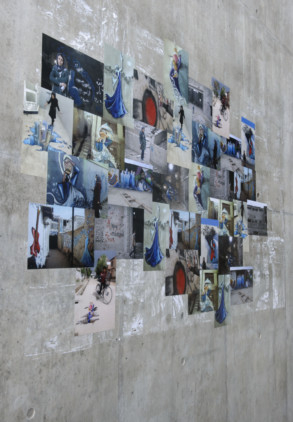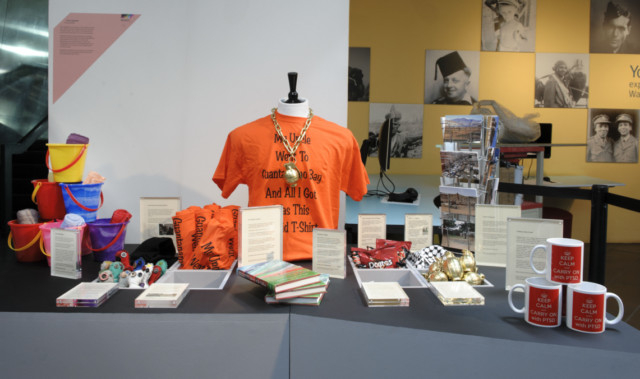
Shamsia Hassani patrols the dusty, often dangerous streets of Kabul, with a weapon in her hand. A spray gun.
She is a graffiti artist, possibly the first in Afghanistan, and her work — spectral women in blue burqas outlined on war-damaged buildings, the dirty, dusty walls and corners of the city — invokes praise and hostility — but mostly hostility.
In fact, such has been the animosity that she has been compelled to stop painting her distinctive images outside and instead take a photograph of the scene she wants to embellish, print out the picture and superimpose an image using acrylic paint to create something that looks like graffiti but is “like a dreaming graffiti. It is graffiti but only in my mind. It is not real.”
Her work is on display at an exhibition at the Imperial War Museum, Manchester, UK, entitled “Conflict and Compassion”, which is part of the city’s Asia Triennial. Her work takes pole position with billboards in front of the museum showing her work and using a quote from her which reads: “It’s very dangerous for a girl to paint in the streets in Kabul.”
Over a series of email exchanges — neither Skype or telephones could overcome the gremlins at work in Kabul — she told me: “Sometimes I am not feeling comfortable to stay for a long time in the street because of security problems — I worry that something will happen and am so afraid that I have to leave. Having to face people with closed minds is another big problem .
“Because graffiti is something new, people will have different ideas and reactions. When I paint outside, people are coming to me, discussing their feelings with me. I was ready to hear bad words from people who were not happy with the artwork but some of them are fighting with me and some people want to stop my artwork.” She, though, had the support of her family.
Shamsia — it means Sunshine — Hassani was born in Iran in 1987 and returned to her homeland in 2005 to pursue her education in fine art at Kabul University, because she would not be allowed to study art in an Iranian university — “you have to live there for 100 years and you would still not be a citizen”.
In 2009, she figured in a list of the top ten artists in the country prepared by the Turquoise Mountain Foundation of Afghanistan, which was established by several foreign governments to help regenerate historic sites and renew traditional Afghan arts. She joined a collective called Roshd, which translates as “growth”, and began her career as a graffiti artist.
“With graffiti I want to cover up all the bad memories of war in people’s minds,” she explains. “If I colour over these bad memories, then I erase war from people’s minds.”
One of her primary concerns is that of women and their role in a society that is prepared, even determined, to keep them oppressed and exploited.
“Images have more effect than words,” she says. “It is a friendly way to fight for women’s rights.”
The result is the images of burqa-clad women, sitting on steps, emblazoned across the old Russian Cultural Centre, framed in doorways.
“I believe there are many who forget all the tragedies women face in Afghanistan, that is why I use my paintings as a means to remind the people,” says Hassani who wears a scarf with her jeans and wedge heels. “I want to highlight the matter in society with paintings of women in burqas everywhere. And I try to show them bigger than what they are in reality, using modern forms, to show their growing strength. I try to make people look at them differently.
“I don’t want to talk only about negative points of their life, about their problems and difficulties, but I want to talk about positive points and their happiness as well. Nothing changes if a woman takes off the burqa. Freedom is not to remove the burqa but it is to have peace, to have equality, to have happiness, to be educated, to have an open mind. It is true that about 90 per cent of their life are affected by problems but sometimes I really enjoy talking about the 10 per cent that is like a small light shining in the darkness. It’s not much but a little light is enough to break the darkness.”
The original collective, Roshd, has been replaced by the Berang Art Organisation — Berang translates as “colourless” — which was started by ten artists who wanted to encourage contemporary art in the country. Hassani is also teaching fine art at Kabul University.
“I want to introduce art to people by using graffiti because they have no chance to visit an art gallery or museums. If I do art, everybody will enjoy it, they will memorise it and slowly it will be part of their life. It will bring some change and give too much colour to people’s minds.”
Alnoor Mitha, curator of the Asia Triennial Manchester, is full of admiration for her courage: “She is reclaiming what we would call a feminist approach, though she might not see it that way. She is reclaiming her cultural history and the country’s cultural history.
“She is empowered by what art is doing, it gives her a voice, lends a new reality for her and for many, which hasn’t happened before. That’s a real transformation for her and her generation. Places are bombed, people live in an unthinkable environment, yet she is motivated to produce this visual narrative which is fantastic. She makes you believe that there is a future for Afghanistan.”
Another Afghan artist showing at the exhibition is Aman Mojadidi. He worked with Hassani and others to set up the Roshd collective and understand the perils of being an artist in that society, having to be secretive if the work he created offends the authorities, showing his works in discreet, pop-up venues. But he has something of a jaundiced view of the way the contemporary art scene is being pursued by its protagonists.
“After the US invasion in 2001 and the war of 2003 there were about eight or nine years when things were fantastic in Kabul for artists,” Mojadidi says. “Afghans were coming home, foreigners were arriving, investing in the country and helping the economy to flourish. It created a whole new middle class of well-paid people and art flourished because of their interest.
“It became chic to support art in Afghanistan and to put on shows. Lots of foreign artists came and for many, there was a prestige attached to buying in Kabul.
“Before the only modern works that could be shown at the National Gallery had to be landscapes, scenes of bazaars, old, white bearded men and birds in cages — nothing interpretative.
“But now more and more Afghans were becoming interested in art that was outside the norm. They could accept something a bit more avant-garde.”
Mojadidi, who was born in the United States to Afghan parents, lived in Kabul for more than ten years until this September. He has a contribution to the show entitled “Commodified” in which he has set up a stall selling what at first appear to be similar souvenirs to the kind available in the official museum shop. But actually on sale are such subversive knick-knacks as grenade necklaces and an orange T-shirt inscribed with the words, “My Uncle went to Guantanamo and all I got was this stupid tee-shirt.”
He seems disillusioned with the present art scene in Kabul — and not just because of government clampdowns and society’s hostility.
“What discouraged me and got me to step back from my involvement with the Roshd collective was that we had got to the point where the artistic process had become entirely dependent on this foreign-aid money,” Mojadidi says. “It had corrupted the creative process.
“Artists like Shamsia have been in newspapers and on TV and been invited around the world to show their work but I still hear Afghan artists saying, ‘We never had any training or workshops, we never get to exhibit’. That’s old rhetoric, the kind of rhetoric that was used to get funding and to sell work.
“That’s not true anymore. For me now the message is: you do it. Make it happen.”
It seems as if Hassani is determined to make it happen.
She writes: “Following so many difficulties such as war, different harsh eras and political issues, Afghanistan is now starting a new life for which I put all my effort through arts to support.”
Richard Holledge is a writer based in London.















